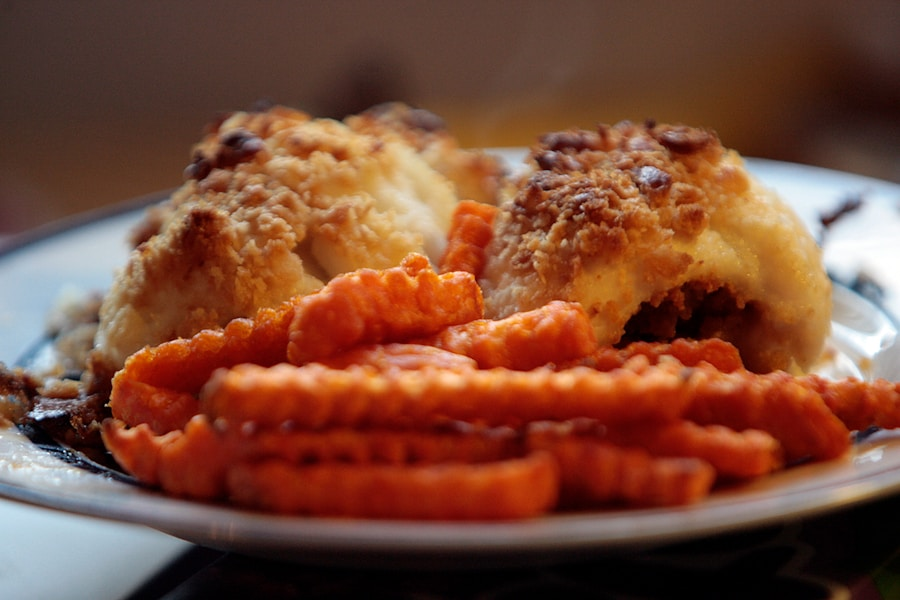
From Scratch: How to Cook Sweet Potato and Chicken Dog Food for a Happy, Healthy Pup
When it comes to feeding our furry friends, many pet owners opt for homemade dog food, such as sweet potato and chicken dog food, over commercial options. There are several benefits to preparing your dog’s meals at home, including knowing exactly what ingredients are going into their food and tailoring their diet to their specific needs. For instance, sweet potato and chicken dog food provide a nutritious combination rich in vitamins and protein. By taking the time to prepare homemade dog food, you can ensure that your dog is getting the nutrition they need to thrive.
One of the main reasons why homemade dog food is a great option is because it allows you to have complete control over what your dog is eating. Many commercial dog foods contain fillers, preservatives, and artificial ingredients that may not be beneficial for your dog’s health. By making your dog food, you can choose high-quality ingredients that are fresh and nutritious.
Cook Sweet Potato and Chicken Dog Food – Benefits
Sweet potatoes and chicken are two ingredients that are commonly used in homemade dog food recipes, and for good reason. Both of these ingredients offer a range of nutritional benefits that can improve your dog’s health.
Sweet potatoes are a great source of vitamins A, C, and B6, as well as dietary fiber. They are also low in fat and contain antioxidants that can help boost your dog’s immune system. Additionally, sweet potatoes are a good source of complex carbohydrates, which provide sustained energy for your pup.
Chicken is a lean source of protein that is easily digestible for dogs. It contains essential amino acids that help support muscle growth and repair. Chicken also provides important vitamins and minerals such as niacin, selenium, and phosphorus. Including chicken in your dog’s diet can help promote healthy skin and coat, as well as overall vitality.
The Importance of a Balanced Diet for Dogs
Just like humans, dogs require a balanced diet to maintain optimal health. A balanced diet for dogs should include a variety of nutrients, including protein, carbohydrates, fats, vitamins, and minerals. Each of these nutrients plays a specific role in your dog’s overall well-being.
Protein is essential for building and repairing tissues, as well as supporting a healthy immune system. Carbohydrates provide energy and fibre, which aids in digestion and headaches. Fats are necessary for healthy skin and coat, as well as for the absorption of certain vitamins. Vitamins and minerals are important for various bodily functions, such as bone health, immune function, and cell growth.
Feeding your dog a balanced diet can help prevent nutritional deficiencies and promote overall health. It is important to consult with your veterinarian to determine the specific nutritional needs of your dog based on their age, breed, size, and activity level.
How to Choose the Right Ingredients to Cook Sweet Potato and Chicken Dog Food
When choosing ingredients for homemade dog food, there are several factors to consider. First and foremost, you want to choose high-quality ingredients that are fresh and free from additives or preservatives. Look for ingredients that are sourced from reputable suppliers and have undergone quality control measures.
It is also important to consider your dog’s specific dietary needs. Some dogs may have allergies or sensitivities to certain ingredients, so it is important to avoid those allergens. Additionally, you should take into account your dog’s age, breed, size, and activity level when selecting ingredients. Puppies and active dogs may require more protein and calories than older or less active dogs.
When it comes to choosing protein sources, lean meats such as chicken, turkey, or fish are generally a good option. Avoid using processed meats or meats that are high in fat or sodium. For carbohydrates, opt for whole grains such as brown rice or quinoa, as well as vegetables like sweet potatoes or carrots.
Preparing Sweet Potatoes for Your Dog’s Meal
Sweet potatoes are a nutritious ingredient that can be easily prepared for your dog’s meals. To prepare sweet potatoes for your dog, start by washing them thoroughly to remove any dirt or debris. You can choose to peel the sweet potatoes or leave the skin on, depending on your dog’s preference and digestion.
Once the sweet potatoes are clean, you can cook them in a variety of ways. One option is to bake them in the oven. Preheat your oven to 400°F (200°C) and place the sweet potatoes on a baking sheet. Bake for about 45 minutes to an hour, or until the sweet potatoes are tender when pierced with a fork.
Another option is to boil the sweet potatoes. Peel and chop the sweet potatoes into small cubes, then place them in a pot of boiling water. Cook for about 15-20 minutes, or until the sweet potatoes are soft and easily mashed.
Cooking Chicken for Your Dog’s Meal
Chicken is a versatile protein source that can be cooked in various ways for your dog’s meals. Before cooking chicken for your dog, it is important to remove any bones, skin, or excess fat. These parts can be difficult for dogs to digest and may pose a choking hazard.
One simple way to cook chicken for your dog is to boil it. Place boneless, skinless chicken breasts or thighs in a pot of water and bring it to a boil. Reduce the heat and simmer for about 20-30 minutes, or until the chicken is cooked through and no longer pink in the center.
Another option is to bake the chicken in the oven. Preheat your oven to 375°F (190°C) and place the chicken breasts or thighs on a baking sheet. Bake for about 25-30 minutes, or until the chicken is cooked through.
Combining Sweet Potatoes and Chicken for a Nutritious Meal
Once you have prepared both the sweet potatoes and chicken, you can combine them to create a nutritious meal for your dog. Start by mashing or chopping the sweet potatoes into small pieces. You can also use a food processor to puree the sweet potatoes if desired.
Next, shred or chop the cooked chicken into small, bite-sized pieces. Mix the chicken with the sweet potatoes until well combined. You can also add in other ingredients such as cooked vegetables or a small amount of cooked whole grains for added nutrition.
It is important to note that when combining sweet potatoes and chicken for your dog’s meal, you should aim for a balanced ratio of protein, carbohydrates, and fats. Consult with your veterinarian to determine the appropriate portion sizes for your dog based on their specific needs.
Adding Supplements and Vitamins to Your Dog’s Food
In addition to providing a balanced diet, it may be necessary to add supplements and vitamins to your dog’s homemade food to ensure they are getting all the necessary nutrients. Supplements can help fill in any nutritional gaps and support your dog’s overall health.
Some common supplements for dogs include fish oil, which is rich in omega-3 fatty acids that promote healthy skin and coat, as well as joint health. Probiotics can also be beneficial for dogs, as they support a healthy digestive system and immune function. Additionally, certain vitamins such as vitamin E and vitamin C may be recommended by your veterinarian based on your dog’s specific needs.
When choosing supplements and vitamins for your dog, it is important to consult with your veterinarian. They can recommend the appropriate products and dosage based on your dog’s individual needs.
Storing Homemade Dog Food for Freshness and Safety
Proper storage is essential for maintaining the freshness and safety of homemade dog food. It is important to store homemade dog food in airtight containers in the refrigerator to prevent spoilage and bacterial growth.
Divide the homemade dog food into individual portions and place them in separate containers or resealable bags. This will make it easier to thaw and serve the appropriate amount for each meal. Label each container with the date and contents to ensure freshness.
If you have prepared a large batch of homemade dog food, you can also freeze individual portions for later use. Freezing homemade dog food can help extend its shelf life and prevent spoilage. Be sure to thaw the frozen portions in the refrigerator before serving to your dog.
It is important to note that homemade dog food should be consumed within a certain timeframe to ensure freshness and safety. Consult with your veterinarian for specific guidelines on how long homemade dog food can be stored.
How to Transition Your Dog to a Homemade Diet
Transitioning your dog to a homemade diet should be done gradually to avoid digestive upset. Start by replacing a small portion of your dog’s current food with homemade dog food. Over the course of several days, gradually increase the amount of homemade food while decreasing the amount of commercial food.
Monitor your dog’s digestion and overall well-being during the transition period. If you notice any signs of digestive upset such as diarrhea or vomiting, slow down the transition process and consult with your veterinarian.
It is important to note that not all dogs may be suitable candidates for a homemade diet. Some dogs may have specific dietary needs or medical conditions that require specialized diets. Always consult with your veterinarian before making any changes to your dog’s diet.
Keeping Your Pup Happy and Healthy with Homemade Cook Sweet Potato and Chicken Dog Food
In conclusion, homemade dog food can be a great option for pet owners who want to have control over what their dogs are eating. By preparing meals at home, you can ensure that your dog is getting the nutrition they need to thrive.
Sweet potatoes and chicken are two ingredients that offer a range of nutritional benefits for dogs. They are both rich in vitamins, minerals, and other essential nutrients that can improve your dog’s health.
When preparing homemade dog food, it is important to choose high-quality ingredients and ensure a balanced ratio of protein, carbohydrates, and fats. Adding supplements and vitamins can help fill in any nutritional gaps.
Proper storage and a gradual transition are important for maintaining the freshness and safety of homemade dog food. By following these guidelines, you can keep your pup happy and healthy with homemade sweet potato and chicken dog food.







